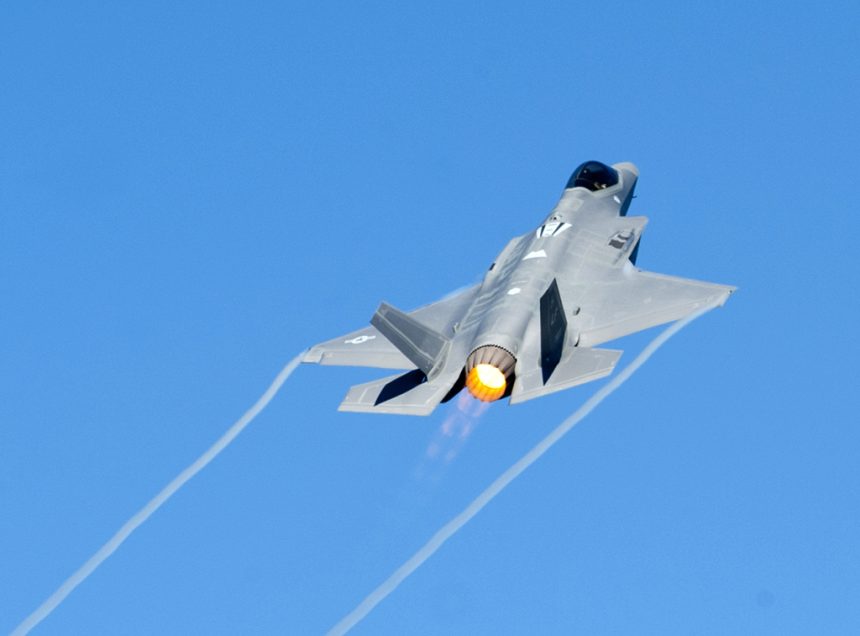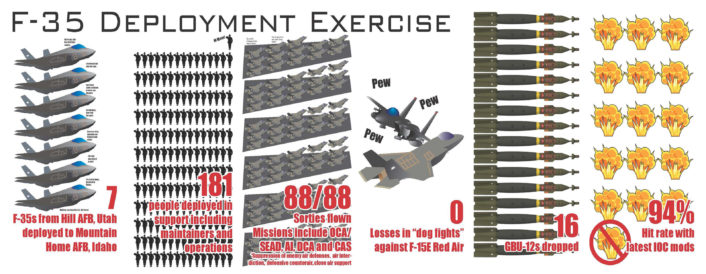“0 losses in 8 dogfights against F-15E Red Air”
The U.S. Air Force F-35A fleet continues to work to declare the Lightning II IOC (initial operational capability) scheduled in the August – December timeframe.
Among the activities carried out in the past weeks, a simulated deployment provided important feedbacks about the goal of demonstrating the F-35’s ability to “penetrate areas with developed air defenses, provide close air support to ground troops and be readily deployable to conflict theaters.”
Seven F-35s deployed from Hill Air Force Base, Utah, to Mountain Home AFB, Idaho, to carry out a series of operational tests which involved local-based 4th Generation F-15E Strike Eagles belonging to the 366th Fighter Wing.
In a Q&A posted on the USAF website, Col. David Chace, the F-35 systems management office chief and lead for F-35 operational requirements at ACC, provided some insights about the activities carried out during the second simulated deployment to Mountain Home (the first was in February this year):
“The F-35 recently deployed from Hill to Mountain Home where crews, maintenance and support personnel conducted a number of missions. During that deployment, crews attained a 100 percent sortie generation rate with 88 of 88 planned sorties and a 94 percent hit rate with 15 of 16 bombs on target.
These numbers provide a positive indication of where we are when it comes to stability and component performance.”
“Feedback from the events at Mountain Home will feed into the overall evaluation of F-35 capabilities. The second evaluation will take place in the operational test environment with F-35 mission sets the Air Force intends to execute after IOC. All reports will be delivered in July and feed into the overall F-35 capabilities report. The ultimate goal is to provide a needed capability to the warfighter to execute the mission. It is not calendar-based or event-based.”
“The feedback from unit operators in place today has been very positive for the F-35, not just concerning performance but the ability the aircraft has with other platforms. In particular at Hill, integration with the F-15E (Strike Eagle) has gone very well. We’ve also been demonstrating the ability to put bombs on target. All of that information will be provided to us in the formal IOC readiness assessments.”
The following interesting chart accompanies the Q&A.
It shows some stats about the deployment.
The fourth column shows something interesting: during the exercise, the F-35s were challenged by some F-15Es and suffered no losses.
Even though the graphic does not say whether the F-35s did shoot back at the F-15Es some analysts (noticing also the “pew pew pew” in the chart….) have suggested the JSFs achieved stunning 8:0 kill rate against the Strike Eagle.
However, the “zero losses” may simply mean that the F-35s were able to complete their assigned strikes without being shot down by the aggressors of the Red Air: considered that the F-15Es were probably equipped with the AN/APG-82 AESA radar and the Sniper ATP (Advanced Targeting Pod), the fact that the Strike Eagles performing DCA (Defensive Counter Air) were not able to “find” and/or “engage” the almost-IOC F-35s can be considered a huge achievement for the pricey, troubled 5th generation multirole combat plane.
Actually, this is not the first time the F-35 proves itself able to fly unscathed through a fighter-defended area: not a single Lightning II was shot down during Green Flag 15-08, the first major exercise conducted, more or less one year ago, on the National Training Center at Fort Irwin, California, during which the F-35 flew as main CAS (Close Air Support) provider.
At that time, several analysts claimed the participation of two test aircraft in the exercise was just a PR stunt, since the aircraft was still quite far from achieving a combat readiness required to really support the troops at war.
Let’s see what happens this time…










